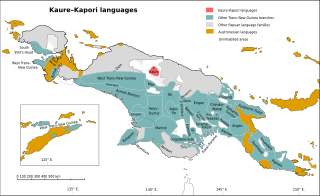Related Research Articles

The East Geelvink Bay or East Cenderawasih languages are a language family of a dozen Papuan languages along the eastern coast of Geelvink Bay in Indonesian Papua, which is also known as Sarera Bay or Cenderawasih.
The Lakes Plain languages are a family of Papuan languages, spoken in the Lakes Plain of Indonesian New Guinea. They are notable for being heavily tonal and for their lack of nasal consonants.
Isirawa is a Papuan language spoken by about two thousand people on the north coast of Papua province, Indonesia. It's a local trade language, and use is vigorous. Stephen Wurm (1975) linked it to the Kwerba languages within the Trans–New Guinea family, and it does share about 20% of its vocabulary with neighboring Kwerba languages. However, based on its pronouns, Malcolm Ross (2005) felt he could not substantiate such a link, and left it as a language isolate. The pronouns are not, however, dissimilar from those of Orya–Tor, which Ross links to Kwerba, and Donahue (2002) accept it as a Greater Kwerba language.

The Asmat – Kamrau Bay languages are a family of a dozen Trans–New Guinea languages spoken by the Asmat and related peoples in southern Western New Guinea. They are believed to be a recent expansion along the south coast, as they are all closely related, and there is little differentiation in their pronouns.

The Kaure–Kosare or Nawa River languages are a small family spoken along the Nawa River in West Papua, near the northern border with Papua New Guinea. The languages are Kaure and Kosare.
The Dani or Baliem Valley languages are a family of clearly related Trans–New Guinea languages spoken by the Dani and related peoples in the Baliem Valley in the Highland Papua, Indonesia. Foley (2003) considers their Trans–New Guinea language group status to be established. They may be most closely related to the languages of Paniai Lakes, but this is not yet clear. Capell (1962) posited that their closest relatives were the Kwerba languages, which Ross (2005) rejects.
Kwoor or Koor is a village in Kwoor, Tambrauw Regency of Southwest Papua, Indonesia on the northern coast of the Bird's Head Peninsula. As of 1994 it was reported to have a population of 589 people.
Tehit is a Papuan language of the Bird's Head Peninsula of New Guinea. Other spellings are Tahit, Tehid, and other names Kaibus, Teminabuan. Dialects are Tehit Jit, Mbol Fle, Saifi, Imyan, Sfa Riere, Fkar, Sawiat Salmeit.
Abun, also known as Yimbun, Anden, Manif, or Karon Pantai, is a Papuan language spoken by the Abun people along the northern coast of the Bird's Head Peninsula in Sausapor District, Tambrauw Regency. It is not closely related to any other language, and though Ross (2005) assigned it to the West Papuan family, based on similarities in pronouns, Palmer (2018), Ethnologue, and Glottolog list it as a language isolate.

Dem is a divergent Papuan language of West New Guinea. Although Palmer (2018) leaves it unclassified, it was tentatively included in the Trans–New Guinea family in the classification of Malcolm Ross (2005), and Timothy Usher ties it most closely to Amung.
Massep is a poorly documented Papuan language spoken by fewer than 50 people in the single village of Masep in West Pantai District, Sarmi Regency, Papua. Despite the small number of speakers, however, language use is vigorous. It is surrounded by the Kwerba languages Airoran and Samarokena.
Samarokena is a poorly documented Papuan language spoken in Indonesian Papua.
Yoke is a poorly documented language spoken by about 200 people in the north of Papua, Indonesia. The name is also spelled Yoki, Yauke, and it is also known as Bitovondo. It was spoken in a single village in the interior until the government relocated a third of the population to a new village, Mantarbori, on the coast. In the late 19th century, a word list of "Pauwi" was collected by Robidé van der Aa at Lake Rombebai, where the Yoke say they migrated from; this is transparently Yoke, apart from some words which do not appear in the modern language but are found in related Warembori.
Berik is a Papuan language spoken in eastern Papua. Speakers are located in four village groups on the Tor River towards the northern coast of Indonesian-controlled Irian Jaya.
Semimi, or Etna Bay, is a Papuan language spoken in Kaimana Regency, West Papua, Indonesia.

Wolani (Wodani) is a Papuan language spoken by about 5,000 people in the Paniai lakes region of the Indonesian province of Central Papua. It is related to the Moni, Ekari, Auye, and Dao languages and may be related to the Dani languages. Documentation is quite limited.
Waritai is a Lakes Plain language of Irian Jaya, Indonesia. It is spoken in Taiyeve.
Duriankari, or Duriankere, is a possibly extinct Papuan language of Indonesian Papua. It is associated with the village of Duriankari at the southern tip of the island of Salawati, which is part of the Raja Ampat Archipelago and is adjacent to the Bird's Head Peninsula of the West Papuan mainland.
The East Pauwasi languages are a family of Papuan languages spoken in north-central New Guinea, on both sides of the Indonesia-Papua New Guinea border. They may either form part of a larger Pauwasi language family along with the Western Pauwasi languages, or they could form an independent language family.
References
- ↑ Airoran at Ethnologue (18th ed., 2015) (subscription required)
- Clouse, Duane, Mark Donohue and Felix Ma. 2002. "Survey report of the north coast of Irian Jaya."
- OLAC resources in and about the Airoran language